![]()
![]()
![]()
Use LEFT and RIGHT arrow keys to navigate between flashcards;
Use UP and DOWN arrow keys to flip the card;
H to show hint;
A reads text to speech;
38 Cards in this Set
- Front
- Back
|
At what age do most cases of eczema began?
|
<5 years old (90%), < 1 year old 60-70%
|
|
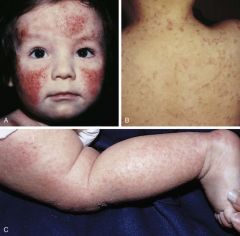
What clinical characteristics define eczema?
|
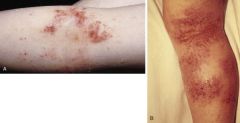
pruritis, chronic/relapsing dz, personal/family hx of atopy, typical distribution (face/extensor in infants, flexor in older children)
|
|
|
Typical locations of eczematous lesions
|
- location of lesions in infants: face and cheeks (sparing of nasolabial folds), extensor extremities (knees, ankles, tops of hands and feet), also sparing of diaper area
- location of lesions in childhood: flexoral extremities, still hands and ankles, but also popliteal fossa, neck, antecubital fossa |
|
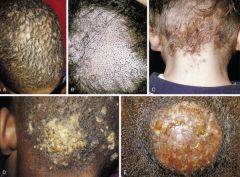
How do you diagnose/treat tinea capitis
|
-Clinical diagnosis. If needed, fungal culture is gold standard (KOH prep also available)
-Treat with systemic antifungal therapy with griseofulvin (eat with fatty meal) for 6-8 weeks-do not need to get routine lab work in healthy children, fluconazole, itraconazole |
|
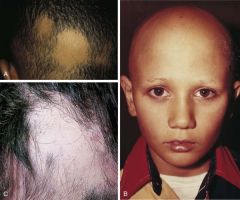
Alopecia and nail pits?
|
Think alopecia areata, treatment with steroids (intralesional and systemic)
|
|
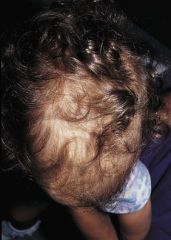
What is telogen effluvium?
|
Diffuse hair loss/thinning secondary to stress/infection/surgery, self limited condition, complete hair growth over time
|
|
|
Pustules in young infant (<7 days of age)
|
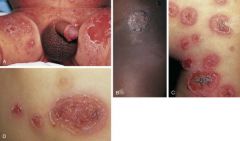
Most likely infectious (bullous impetigo), dx with gram stain/bacterial culture. In pustular melanosis pustules are only present right after birth and are quickly washed off.
Bollous impetigo-multiple pustules most common in diaper region and lower abdomen (picture staph diaper dermatits |
|
|
How do you diagnose transient neonatal pustular melanosis?
|

Clinical. But can also do Wright stain (neutrophils but no bacteria). The first stage (the papules) do not last very long. The third stage is hyperpigmented macules.
|
|
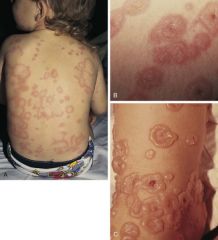
What is this?
|
Erythema Multiforme Minor-fixed targetoid lesions +/- mucous membrane involvement. Self limited. Most common cause is HSV. DDx = annular urticaria (edema but not necrosis-will have central clearing vs central duskiness as in erythema multiforme)
|
|
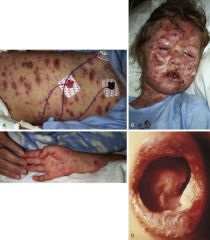
What diagnosis is this? You see thick hemorrhagic crusting of lips and targetoid lesions on skin followed by 7 day course of bactrim?
|
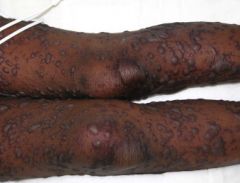
SJS/erythema multiforme major: acutely ill, prodromal symptoms of fever and malaise. Mucuous membrane invovlement occurs first followed by skin involvement. Must have 2 mucous membranes involved. if >10% of skin denuded then diagnosis is TEN.
Common drugs: Sulfa drugs, doxycycline, lamotrigine, phenytoin, phenobarbital, PCN/cephalosporins, allopurinol and infections (mycoplasma PNA) |
|
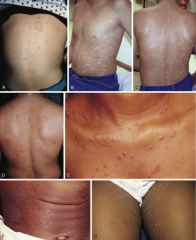
Rash that begins with scaly herald patch (resembles tinea corporis) then gradually spread in a Christmas tree distribution?
|
Pityriasis Rosea.
Is a self limited condition, no treatment necessary, but UV light can be helpful. DDX is secondary syphilis. |
|
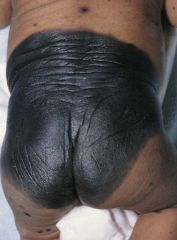
What are you at risk for if you have a large (>20 cm) congenital melanocytic nevi?
|
Neurocutaneous melanosis, pre pubertal melanoma, dandy-walker syndrome
|
|
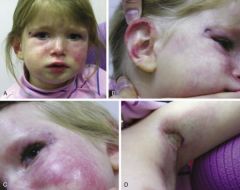
Myopathy, Heliotrope rash, Gottron's papules over knuckles, joint involvement, dilated capillary nailbed vessels
|
Juvenile dermatomyositis
|
|
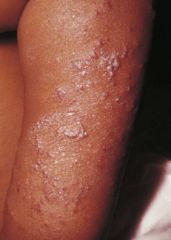
What is this?
|
Papular urticaria (multiple urticarial papules, frequently clustered, very pruritic, can get secondary infection). Think of bug bite.
|
|
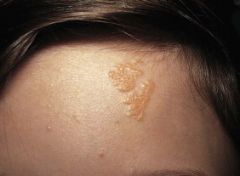
Waxy hamartoma of appendageal structures (type of epidermal nevus).
|
Nevus sebaceous.
Seen most prominently on scalp. waxy plaque Can present as alopecia |
|
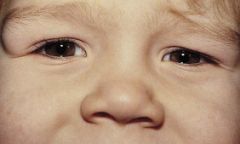
What is this?
|
Dermoid cyst (These cysts present as smooth, painless, mobile, subcutaneous, round or oval masses. Dermoid cysts are most frequently located in the lateral brow area adjacent to the zygomaticofrontal suture.)
CNS extension is more common when occurs on midline scalp or a cutaneous nasal lesions or when associated with a cutaneous dimple or sinus |
|
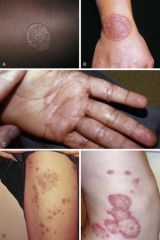
Treatment of tinea corporis
|
Annular plaque (ddx includes nummular eczema, granulmoa annulare)
DX: fungal culture or KOH scraping Tx: topical treatment for 2-4 weeks, can use oral/systemic therapy if hair involvement, diffuse rash, immunocompromised. Includes griseofulvin. |
|
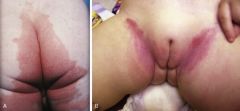
What is this?
|
Diaper psoriasis. See rash in skin folds. think of it if doesn't respond to candidal therapy.
|
|
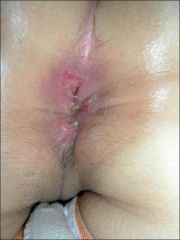
Perianal erythema
|
Streptococcal infection vs zinc deficiency (triad of acral/around the mouth dermatitis, alopecia, diarrhea and irritability) vs child abuse.
|
|
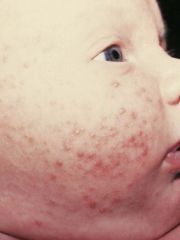
Neonatal (cephallic pustulosis) vs infantile acne
(Above is neonatal) |
Neonatal acne occurs in first three weeks of life (no comedones) and usually resolves spontaneously
Infantile acne occurs at 3-4 months and sometimes does require treatment with benzoyl peroxide (see open and closed comedones) |
|
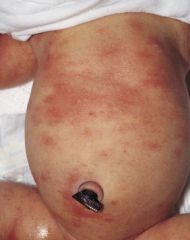
Small pustules filled with eosinophils
|
Erythema toxicum
|
|
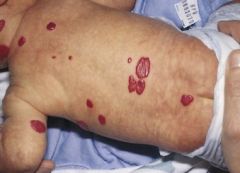
What locations of infantile hemangiomas warrant referral or further investigation?
|
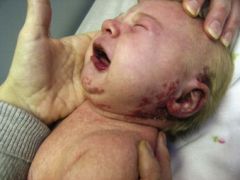
Periorbital lesions (occular complications), beard lesions (concern for airway issues including subglottic hemangiomas), tip of nose/ear/lip (greater tendecy to ulcerate), midline lumbosacral region (increased risk for spinal involvement, MRI is best diagnostic tool).
Start involuting by age 2, 50% gone by 5 years, 90% by 9 years |
|
|
What is PHACES syndrome?
|
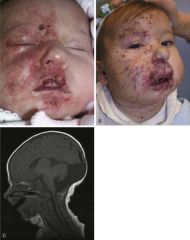
Large segmental facial hemangioma puts child at risk for this syndrome.
Posterior fossa abnormalities (dandy walker syndrome) Hemangioma Arterial anomalies (usually intracerebral) Cardiac defects, esp coarctation Eye abnormalities |
|
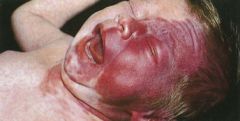
In Sturge Weber syndrome what eye condition are they at risk for?
|
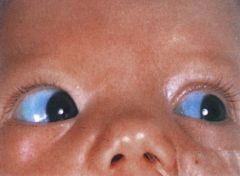
Glaucoma-first screen these kids with a full ophthalmologic evaluation (Buphthalmos is pictured above)
Other associations include -Facial port wine stains in V1 distribution (more common if bilateral facial lesions) -Neuro complications include seizures, MR, hemiplegia (in Sturge Weber syndrome seizures and MR are common unlike in NF). MRI is best diagnostic tool. |
|
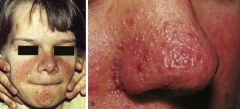
Tuberous Sclerosis skin findings
|
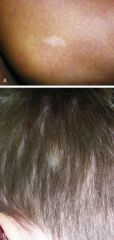
AD, disease characterized by hamartomas of skin, brain, eye, kidneys, heart, lungs and bone.
Hypopigmented macules (ash leaf, one of earliest skin findings) and Facial angiofibromas (sparing of forehead, cheeks and nasolabial folds) are most commonly seen. Can also see fibromas (later finding) and collagenomas (shagreen patch if in lumbosacral area). WITH TS have high likelihood of seizure, MR and brain calcifications |
|
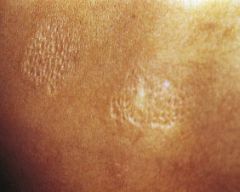
What is this and what is it associated with?
|
Shagreen patch. Tuberous Sclerosis.
|
|
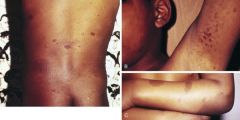
Several tan to light brown patches/macules over trunk are observed -what is your next step?
|
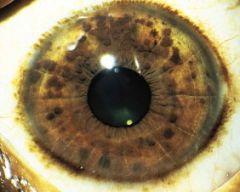
These are cafe au lait spots. IF you see a large (>3 cm) or multiple lesions (>6) then you may suspect Neurofibromatosis
Other characteristics include positive family hx, possible eye complications including optic glioma (and Lisch nodules shown above), macrocephaly, skin findings/Crowe's sign (freckling of axillary/inguinal skin, fibromas). In this disease your main concern is neurofibromas. |
|

Orange/brown macules/patches, some edematous and erythematous, worse after hot bath
|
Solitary mastocytomas (5 or less lesions)
Usually present at birth, and appear by 2 years of age, yellow/brown, oval, slightly raised. Surface may have orange peel texture. Hx of intermittent urtication. When rub lesions, see wheal/urtication from histamine release (darier sign) |
|
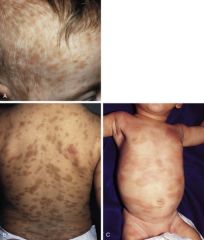
Diagnosis of this rash?
|
Urticaria pigmentosa (most common presentation of mast cell disease). Multiple macules/plaques. Urticarial flares are also common.
|
|
|
What do you suspect with segmental cafe au lait macules, precious puberty, hyperthyroidism, polyostotic fibrous dysplasia? McCune Albright syndrome
|
McCune Albright syndrome
|
|
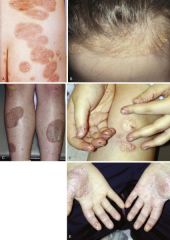
What is this?
|
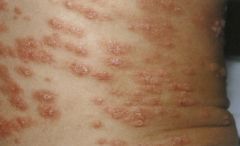
Psoriasis. Red, well-demarcated plaques covered with dry, thick, silvery scales. Lesions of psoriasis are often induced at sites of local injury such as scratches, surgical scars, or sunburn, a response termed the Koebner phenomenon
|
|

What is this? Distribution is unilateral. Rash is asymptomatic.
|
Lichen striatus: linear band of coalescing skin colored papules, usually unilateral. It is asymptomatic and self resolves.
|
|
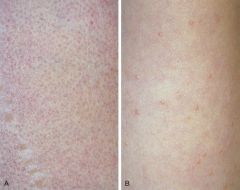
What is this?
|
Keratosis pylaris. Common, asymptomaic. papules on cheeks, extensors and buttocks. Has a very rough texture.
|
|
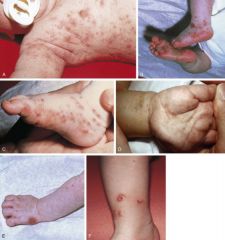
What is this?
|
Infantile scabies.
Pruritis and red papules, vesicles, pustules, nodules, crusted papules and possible burrows. Involves trunk, hands, feet, web spaces, axilla and genitalia. Tx with 5% permetrhin cream, repeat in one week, treat all family members |
|
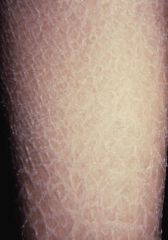
Rash. Improves with warm, humid weather. Flexural sparing.
|
ichthyosis vulgaris. Retention hyperkeratosis. Similar genetic mutation as eczema. Diffuse scaling with flexural sparing. Hyperlinearity of palms and soles. Improved with warm, humid weather.
|
|
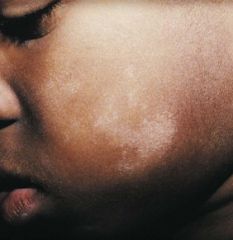
Pityriasis Alba
|
Hypopigmented (not de pigmented lesions). Usually seen with patients with atopic dermatitis or xerosis. More obvious in sunlight.
|
|

Patient with a eczema presents with this rash?
|
Eczema herpeticum.
Frequently have associated systemic symptoms. Clustered blisters, pustules or punches out erosion. If suspect, treat empirically. Often with antibacterials and antivirals at the same time. |
|

Treatment of acne
|
-Topical therapy: benzoyl peroxide (useful in all stages of acne), topical retinoids (usually most consider to be first line therapy as well since it works to prevent formation of new comedones), topical antibiotics
-systemic: oral abx, oral retinoids and finally OCPS Use oral abx if failed topical therapy or with moderate to severe inflammatory acne. |

